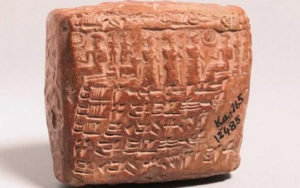
4,000-Year-Old Prenup Details Surrogacy Rules
4,000-Year-Old Prenup Details Surrogacy Rules
November 14, 2017
The Times of Israel – The cradle of civilization is also the birthplace of surrogate motherhood, according to a recently deciphered cuneiform tablet from Turkey.
The first historical reference to infertility and surrogacy was found in a trove in Turkey’s Kayseri province. And, unlike the famous biblical surrogacy of Hagar which resulted in bitter rivalry, this contractual surrogate mother would have been freed from slavery after the birth of a male child.
Prof. Emeritus Liubov Ben-Nun, of BGU’s Joyce and Irving Goldman Medical School, explores the topics of infertility and surrogacy in his book, Surrogate Motherhood: Hagar and Sarah.
“At her advanced age, Sarah was an infertile woman. She desperately wanted a child, so she gave Hagar to Abraham to be his wife. Since Hagar agreed to give birth to a baby on behalf of Sarah, we can define Hagar as a surrogate mother,” says Prof. Ben-Nun.
However, explains Prof. Ben- Nun, because not enough care was taken in the contract between Sarah and Hagar to prevent a loss of status to Sarah, the family’s fabric was frayed.
“Persistent continuous tension between Sarah and Hagar poisoned the internal family atmosphere, so that hostile confrontations, jealousy and hatred between the women broke the equilibrium of Abraham’s family,” he writes.
“Lack of comprehension and adequate handling of continuous stresses led to severe disequilibrium in this family. The crisis deepened, deteriorated slowly and disintegration followed. This is indicated by Sarah’s request ‘…Cast out this bondwoman and her son…’ in Genesis 21:10.”
The newly discovered ancient Assyrian prenup would have eased such family drama before its inception through its stipulation that the surrogate mother be freed once a male child was born.
The 4,000-year-old Assyrian clay tablet was discovered during modern excavations of a site where some 1,000 such tablets were uncovered in 1925. Today they are known by scholars as the Cappadocian tablets, and since 2014 the site of Kültepe-Kanesh has appeared on the UNESCO World Heritage List.




